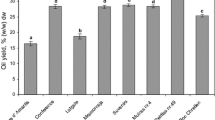Abstract
Chemical composition and physical properties of CW88-OL and CW99-OL cultivars of high oleic safflower seeds and their hexane-extracted oils were determined. Dry-based seed composition of CW88-OL and CW99-OL was: moisture = 4.29 and 4.23 %, oil = 42.29 and 46.44 %, Crude protein = 20.94 and 16.41 %, neutral detergent fiber = 28.11 and 28.49 %, ash = 1.55 and 2.01 %, phosphorus content = 2033 and 3995 mg/kg, respectively. Major fatty acids in oils were ~78 % oleic (O), ~13 % linoleic (L), ~5 % palmitic (P) and ~2 % stearic (St) acids, for both cultivars. The main triacylglycerols were OOO (~50 %), OOL (~20 %), SOL + OPO (~10 %), and LLP (~5 %). The oil composition of CW88-OL and CW99-OL in main minor components was: α-tocopherol = 582 and 551 mg/kg, total sterols = 3996 and 3362 mg/kg, phospholipids = 22 and 21 mg/kg and wax content = 70 and 74 mg/kg. For both cultivars, density and viscosity of the oils between 25 and 55 °C varied from 903.4 to 912.6 kg/m3 and 63 to 23 mPa.s showing linear and exponential behaviors, respectively. The refractive index was 1.4694. The CIELab color parameters were: 89.69 and 89.53 (L*), −3.72 and −3.07 (a*), and 47.28 and 47.78 (b*) (CW88-OL and CW99-OL, respectively). Thus, the high oil content of the seeds and nutritional quality of the oil accompanied by low levels of waxes and phospholipids makes the cultivars studied promising for producers and consumers.


Similar content being viewed by others
References
Smith JR (1996) Safflower. AOCS, Champaign
Gunstone F (1996) Fatty acid and lipid chemistry. Springer Science + Business Media, Dordrecht
Bozan B, Temelli F (2008) Chemical composition and oxidative stability of flax, safflower and poppy seed and seed oils. Bioresour Technol 99:6354–6359
Mihaela P, Josef R, Monica N, Rudolf Z (2013) Perspectives of safflower oil as biodiesel source for South Eastern Europe (comparative study: Safflower, soybean and rapeseed). Fuel 111:114–119
Vosoughkia M, Ghavamib M, Gharachorloo M, Sharrifmoghaddasi M, Omidi AH (2011) Lipid composition and oxidative stability of oils in safflower (Carthamus Tinctorius L.) seed lines grown in Iran. Adv Environ Biol 5:897–902
Matthaus B, Özcan MM, Al Juhaimi FY (2015) Fatty acid composition and tocopherol profiles of safflower (Carthamus tinctorius L.) seed oils. Nat Prod Res 29(2):193–196
Conte LS, Frega N, Capella P (1983) Composition of the unsaponifiable oil fraction obtained from a number of cultivars of safflower. J Am Oil Chem Soc 60:2003–2006
Fernández-Cuesta A, Fernández-Martínez JM, Velasco L (2013) Variation for seed phytosterols in a set of safflower cultivars. J Food Agric Environm 11:656–660
AOCS (2009) Official methods and recommended practices of the American Oil Chemist´s Society, vol 5th. The American Oil Chemist´s Society, Champaign
International Union of Pure, Applied Chemistry (IUPAC) (1992) Standard methods for the analysis of oils, fats and derivatives, 7th edn. Blackwell Scientific Publications, Oxford
AOAC (2000) Official methods of analysis of the association of official analytical chemists international. In: Horwitz W (ed) Association of Official Analytical Chemists, 17th edn. Gaithersburg
Van Soest P, Robertson J, Lewis B (1991) Methods for dietary fiber, neutral detergent fiber and non-starch polysaccharides in relation to animal nutrition. J Dairy Sci 74:3583–3597
Official Journal of the European Union, DO L248 (05.09.1991) On the Characteristics of Olive Oil and Olive-Residue and of the Relevant Methods of analysis. Annex V: Determination of the composition and content of sterols by capillary-column gas chromatography, pp 15–22
Carelli AA, Brevedan MIV, Crapiste GH (1997) Quantitative determination of phospholipids in sunflower oil. J Am Oil Chem Soc 74:511–514
Carelli AA, Bäumler EB, Ceci LN (2012) Improved method for the determination of wax esters in vegetable oils. Eur J Lipid Sci Technol 114:1312–1319
Institute of Medicine (US) Standing Committee on the Scientific Evaluation of Dietary Reference Intakes (1997) Dietary References Intakes for calcium, phosphorus,magnesium, vitamin D and fluoride. National Academy of Sciences (US), Washington (DC)
O’Brien R (2014) Fats and oils. CRC Press, New York
International Olive Oil Council (2015) Trade standard applying to olive oils and olive-pomace oils. COI/T.15/NC No. 3/Rev. http://www.internationaloliveoil.org. Accessed July 2016
Ceci LN, Carelli AA (2010) Relation between oxidative stability and composition in Argentinian olive oils. J Am Oil Chem Soc 87:1189–1197
Carrín ME, Carelli AA (2010) Changes in quality and composition of sunflower oil during processing and storage. In: Tomas M (ed) Advances in fats and oil research. Transworld Research Network, Kerala
Warner K, Vick V, Kleingartner L, Isaak R, Doroff K (2003) Compositions of sunflower, Nusun (mid-oleic sunflower) and high-oleic sunflower oils. https://www.sunflowernsa.com/uploads/35/warner_.pdf. Accessed 10 July 2016
Carelli AA, Ceci LN, Crapiste GH (2002) Phosphorus-to-phospholipid conversion factors for crude and degummed sunflower oils. J Am Oil Chem Soc 79:1177–1180
Rafiquzzaman M, Hossain MA, Hasan AJMM (2006) Studies on the characterization and glyceride composition of safflower (Carthamus tinctorius) seed oil. Bangladesh J Sci Ind Res 41:235–23824
Lee YC, Oh SW, Chang J, Kim IJ (2004) Chemical composition and oxidative stability of safflower oil prepared with expeller from safflower seeds roasted at different temperatures. Food Chem 84:1–6
Acknowledgments
This work was funded by CONICET (Consejo Nacional de Investigaciones Científicas y Técnicas), ANPCyT (Agencia Nacional de Promoción Científica y Tecnológica) and Universidad Nacional del Sur, Argentina. The authors wish to acknowledge Clarisa Cicchelli, Pedro Forbito and Federico Delucchi for their kind assistance during the analytical work.
Author information
Authors and Affiliations
Corresponding author
Ethics declarations
Conflict of Interest
The authors have declared no conflict of interest.
About this article
Cite this article
Salaberría, F., Constenla, D., Carelli, A.A. et al. Chemical Composition and Physical Properties of High Oleic Safflower Oils (Carthamus tinctorius, Var. CW88-OL and CW99-OL). J Am Oil Chem Soc 93, 1383–1391 (2016). https://doi.org/10.1007/s11746-016-2886-6
Received:
Accepted:
Published:
Issue Date:
DOI: https://doi.org/10.1007/s11746-016-2886-6




